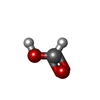[English] 日本語
 Yorodumi
Yorodumi- PDB-1jqz: Human Acidic Fibroblast Growth Factor. 141 Amino Acid Form with A... -
+ Open data
Open data
- Basic information
Basic information
| Entry | Database: PDB / ID: 1jqz | ||||||
|---|---|---|---|---|---|---|---|
| Title | Human Acidic Fibroblast Growth Factor. 141 Amino Acid Form with Amino Terminal His Tag. | ||||||
 Components Components | acidic fibroblast growth factor FGF1 FGF1 | ||||||
 Keywords Keywords | HORMONE/GROWTH FACTOR / beta-trefoil / HORMONE-GROWTH FACTOR COMPLEX | ||||||
| Function / homology |  Function and homology information Function and homology informationmesonephric epithelium development / branch elongation involved in ureteric bud branching / regulation of endothelial tube morphogenesis / FGFR3b ligand binding and activation / regulation of endothelial cell chemotaxis to fibroblast growth factor / Signaling by activated point mutants of FGFR3 / FGFR3c ligand binding and activation / Phospholipase C-mediated cascade; FGFR3 / FGFR2b ligand binding and activation / positive regulation of cholesterol biosynthetic process ...mesonephric epithelium development / branch elongation involved in ureteric bud branching / regulation of endothelial tube morphogenesis / FGFR3b ligand binding and activation / regulation of endothelial cell chemotaxis to fibroblast growth factor / Signaling by activated point mutants of FGFR3 / FGFR3c ligand binding and activation / Phospholipase C-mediated cascade; FGFR3 / FGFR2b ligand binding and activation / positive regulation of cholesterol biosynthetic process /  fibroblast growth factor receptor binding / FGFR2c ligand binding and activation / Activated point mutants of FGFR2 / Phospholipase C-mediated cascade; FGFR2 / FGFR4 ligand binding and activation / FGFR1b ligand binding and activation / Phospholipase C-mediated cascade; FGFR4 / Signaling by activated point mutants of FGFR1 / FGFR1c ligand binding and activation / organ induction / Downstream signaling of activated FGFR1 / Phospholipase C-mediated cascade: FGFR1 / positive regulation of hepatocyte proliferation / S100 protein binding / positive regulation of intracellular signal transduction / Signaling by FGFR2 IIIa TM / PI-3K cascade:FGFR3 / positive regulation of sprouting angiogenesis / PI-3K cascade:FGFR2 / PI-3K cascade:FGFR4 / PI-3K cascade:FGFR1 / positive regulation of cell division / PI3K Cascade / anatomical structure morphogenesis / fibroblast growth factor receptor signaling pathway / SHC-mediated cascade:FGFR3 / SHC-mediated cascade:FGFR2 / SHC-mediated cascade:FGFR4 / SHC-mediated cascade:FGFR1 / FRS-mediated FGFR3 signaling / FRS-mediated FGFR2 signaling / FRS-mediated FGFR4 signaling / Signaling by FGFR3 in disease / FRS-mediated FGFR1 signaling / fibroblast growth factor receptor binding / FGFR2c ligand binding and activation / Activated point mutants of FGFR2 / Phospholipase C-mediated cascade; FGFR2 / FGFR4 ligand binding and activation / FGFR1b ligand binding and activation / Phospholipase C-mediated cascade; FGFR4 / Signaling by activated point mutants of FGFR1 / FGFR1c ligand binding and activation / organ induction / Downstream signaling of activated FGFR1 / Phospholipase C-mediated cascade: FGFR1 / positive regulation of hepatocyte proliferation / S100 protein binding / positive regulation of intracellular signal transduction / Signaling by FGFR2 IIIa TM / PI-3K cascade:FGFR3 / positive regulation of sprouting angiogenesis / PI-3K cascade:FGFR2 / PI-3K cascade:FGFR4 / PI-3K cascade:FGFR1 / positive regulation of cell division / PI3K Cascade / anatomical structure morphogenesis / fibroblast growth factor receptor signaling pathway / SHC-mediated cascade:FGFR3 / SHC-mediated cascade:FGFR2 / SHC-mediated cascade:FGFR4 / SHC-mediated cascade:FGFR1 / FRS-mediated FGFR3 signaling / FRS-mediated FGFR2 signaling / FRS-mediated FGFR4 signaling / Signaling by FGFR3 in disease / FRS-mediated FGFR1 signaling /  Hsp70 protein binding / Signaling by FGFR2 in disease / Hsp70 protein binding / Signaling by FGFR2 in disease /  extracellular matrix / Signaling by FGFR1 in disease / activation of protein kinase B activity / positive regulation of endothelial cell migration / epithelial cell proliferation / positive regulation of epithelial cell proliferation / Negative regulation of FGFR3 signaling / Negative regulation of FGFR2 signaling / Negative regulation of FGFR4 signaling / Negative regulation of FGFR1 signaling / animal organ morphogenesis / lung development / extracellular matrix / Signaling by FGFR1 in disease / activation of protein kinase B activity / positive regulation of endothelial cell migration / epithelial cell proliferation / positive regulation of epithelial cell proliferation / Negative regulation of FGFR3 signaling / Negative regulation of FGFR2 signaling / Negative regulation of FGFR4 signaling / Negative regulation of FGFR1 signaling / animal organ morphogenesis / lung development /  growth factor activity / positive regulation of MAP kinase activity / growth factor activity / positive regulation of MAP kinase activity /  wound healing / positive regulation of angiogenesis / Constitutive Signaling by Aberrant PI3K in Cancer / wound healing / positive regulation of angiogenesis / Constitutive Signaling by Aberrant PI3K in Cancer /  integrin binding / PIP3 activates AKT signaling / cellular response to heat / integrin binding / PIP3 activates AKT signaling / cellular response to heat /  heparin binding / heparin binding /  cell cortex / PI5P, PP2A and IER3 Regulate PI3K/AKT Signaling / RAF/MAP kinase cascade / cell cortex / PI5P, PP2A and IER3 Regulate PI3K/AKT Signaling / RAF/MAP kinase cascade /  angiogenesis / angiogenesis /  cell differentiation / positive regulation of ERK1 and ERK2 cascade / positive regulation of cell migration / positive regulation of cell population proliferation / positive regulation of gene expression / cell differentiation / positive regulation of ERK1 and ERK2 cascade / positive regulation of cell migration / positive regulation of cell population proliferation / positive regulation of gene expression /  signal transduction / positive regulation of transcription by RNA polymerase II / signal transduction / positive regulation of transcription by RNA polymerase II /  extracellular space / extracellular region / extracellular space / extracellular region /  nucleoplasm / nucleoplasm /  nucleus / nucleus /  cytosol / cytosol /  cytoplasm cytoplasmSimilarity search - Function | ||||||
| Biological species |   Homo sapiens (human) Homo sapiens (human) | ||||||
| Method |  X-RAY DIFFRACTION / X-RAY DIFFRACTION /  MOLECULAR REPLACEMENT / Resolution: 1.65 Å MOLECULAR REPLACEMENT / Resolution: 1.65 Å | ||||||
 Authors Authors | Brych, S.R. / Blaber, S.I. / Logan, T.M. / Blaber, M. | ||||||
 Citation Citation |  Journal: Protein Sci. / Year: 2001 Journal: Protein Sci. / Year: 2001Title: Structure and stability effects of mutations designed to increase the primary sequence symmetry within the core region of a beta-trefoil. Authors: Brych, S.R. / Blaber, S.I. / Logan, T.M. / Blaber, M. | ||||||
| History |
|
- Structure visualization
Structure visualization
| Structure viewer | Molecule:  Molmil Molmil Jmol/JSmol Jmol/JSmol |
|---|
- Downloads & links
Downloads & links
- Download
Download
| PDBx/mmCIF format |  1jqz.cif.gz 1jqz.cif.gz | 73.4 KB | Display |  PDBx/mmCIF format PDBx/mmCIF format |
|---|---|---|---|---|
| PDB format |  pdb1jqz.ent.gz pdb1jqz.ent.gz | 54.5 KB | Display |  PDB format PDB format |
| PDBx/mmJSON format |  1jqz.json.gz 1jqz.json.gz | Tree view |  PDBx/mmJSON format PDBx/mmJSON format | |
| Others |  Other downloads Other downloads |
-Validation report
| Arichive directory |  https://data.pdbj.org/pub/pdb/validation_reports/jq/1jqz https://data.pdbj.org/pub/pdb/validation_reports/jq/1jqz ftp://data.pdbj.org/pub/pdb/validation_reports/jq/1jqz ftp://data.pdbj.org/pub/pdb/validation_reports/jq/1jqz | HTTPS FTP |
|---|
-Related structure data
| Related structure data |  1jt3C 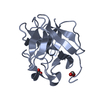 1jt4C  1jt5C 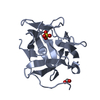 1jt7C 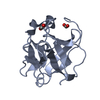 1jtcC  2afgS C: citing same article ( S: Starting model for refinement |
|---|---|
| Similar structure data |
- Links
Links
- Assembly
Assembly
| Deposited unit | 
| ||||||||
|---|---|---|---|---|---|---|---|---|---|
| 1 | 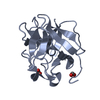
| ||||||||
| 2 | 
| ||||||||
| Unit cell |
|
- Components
Components
| #1: Protein |  FGF1 / HEPARIN-BINDING GROWTH FACTOR 1 / HBGF-1 / AFGF FGF1 / HEPARIN-BINDING GROWTH FACTOR 1 / HBGF-1 / AFGFMass: 16686.748 Da / Num. of mol.: 2 Source method: isolated from a genetically manipulated source Source: (gene. exp.)   Homo sapiens (human) / Production host: Homo sapiens (human) / Production host:   Escherichia coli (E. coli) / References: UniProt: P05230 Escherichia coli (E. coli) / References: UniProt: P05230#2: Chemical | ChemComp-FMT /  Formic acid Formic acid#3: Water | ChemComp-HOH / |  Water Water |
|---|
-Experimental details
-Experiment
| Experiment | Method:  X-RAY DIFFRACTION / Number of used crystals: 1 X-RAY DIFFRACTION / Number of used crystals: 1 |
|---|
- Sample preparation
Sample preparation
| Crystal | Density Matthews: 2.96 Å3/Da / Density % sol: 57.98 % | ||||||||||||||||||||
|---|---|---|---|---|---|---|---|---|---|---|---|---|---|---|---|---|---|---|---|---|---|
Crystal grow | Temperature: 283 K / Method: vapor diffusion, hanging drop / pH: 5.8 Details: sodium formate, ammonium sulfate, pH 5.8, VAPOR DIFFUSION, HANGING DROP, temperature 283K | ||||||||||||||||||||
| Crystal grow | *PLUS Temperature: 4 or 10 ℃ | ||||||||||||||||||||
| Components of the solutions | *PLUS
|
-Data collection
| Diffraction | Mean temperature: 103 K |
|---|---|
| Diffraction source | Source:  ROTATING ANODE / Type: RIGAKU / Wavelength: 1.5418 Å ROTATING ANODE / Type: RIGAKU / Wavelength: 1.5418 Å |
| Detector | Type: RIGAKU RAXIS IIC / Detector: IMAGE PLATE / Date: Feb 25, 2000 / Details: Osmic Blue confocal mirrors |
| Radiation | Monochromator: Osmic Mirrors / Protocol: SINGLE WAVELENGTH / Monochromatic (M) / Laue (L): M / Scattering type: x-ray |
| Radiation wavelength | Wavelength : 1.5418 Å / Relative weight: 1 : 1.5418 Å / Relative weight: 1 |
| Reflection | Resolution: 1.65→44.3 Å / Num. all: 47449 / Num. obs: 46354 / % possible obs: 97.6 % / Observed criterion σ(F): 3 / Observed criterion σ(I): 3 / Redundancy: 5.4 % / Biso Wilson estimate: 16.2 Å2 / Rmerge(I) obs: 0.053 / Net I/σ(I): 41.6 |
| Reflection shell | Resolution: 1.65→1.68 Å / Rmerge(I) obs: 0.197 / Mean I/σ(I) obs: 5.3 / % possible all: 83.5 |
- Processing
Processing
| Software |
| ||||||||||||||||
|---|---|---|---|---|---|---|---|---|---|---|---|---|---|---|---|---|---|
| Refinement | Method to determine structure : :  MOLECULAR REPLACEMENT MOLECULAR REPLACEMENTStarting model: 2AFG Resolution: 1.65→44.3 Å / Isotropic thermal model: TRONRUD / Stereochemistry target values: TRONRUD
| ||||||||||||||||
| Solvent computation | Solvent model: TNT / Bsol: 222 Å2 / ksol: 0.96 e/Å3 | ||||||||||||||||
| Refinement step | Cycle: LAST / Resolution: 1.65→44.3 Å
| ||||||||||||||||
| Refine LS restraints |
| ||||||||||||||||
| LS refinement shell | Resolution: 1.65→1.68 Å /
| ||||||||||||||||
| Software | *PLUS Name: TNT / Classification: refinement | ||||||||||||||||
| Refinement | *PLUS Num. reflection Rfree: 4477 / % reflection Rfree: 10 % / Rfactor obs: 0.204 / Rfactor Rfree : 0.241 / Rfactor Rwork : 0.241 / Rfactor Rwork : 0.2 : 0.2 | ||||||||||||||||
| Solvent computation | *PLUS | ||||||||||||||||
| Displacement parameters | *PLUS | ||||||||||||||||
| Refine LS restraints | *PLUS
|
 Movie
Movie Controller
Controller















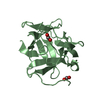




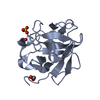

 PDBj
PDBj



